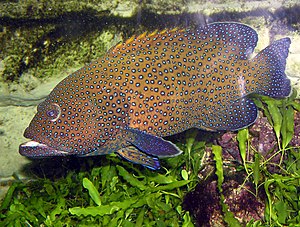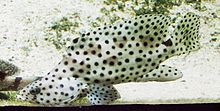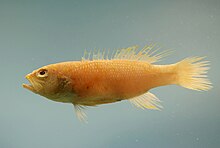Groupers
| Groupers | ||||||||||||
|---|---|---|---|---|---|---|---|---|---|---|---|---|

Peacock grouper ( Cephalopholis argus ) |
||||||||||||
| Systematics | ||||||||||||
|
||||||||||||
| Scientific name | ||||||||||||
| Epinephelidae | ||||||||||||
| Bleeker , 1871 |
The groupers (Epinephelidae) are a family of small to very large marine fish from the order of the perch-like (Perciformes). They include the dark giant grouper ( Epinephelus lanceolatus ), one of the largest known reef fish - this can be over 2.5 meters tall. Almost all groupers live close to the coast in tropical and subtropical regions of all oceans. Most species live in shallower water above 300 meters, only a few below.
features
Many groupers are large, massive fish of the typical perch shape. Their size ranges from 2.3 centimeters long Pseudogramma guineensis to the dark giant grouper ( Epinephelus lanceolatus ), which can be 2.70 meters long and up to 400 kilograms. Most species, however, reach sizes between 20 and 80 centimeters.
There are three thorns on the gill cover , a central large one and a small one above and below. The gill cover is finely serrated. The sideline is complete and does not extend to the caudal fin. The dorsal fin is usually continuous, the hard and soft part can be separated from each other by an indentation. Your front part is supported by seven to eleven spines. The anal fin has three spines, the pelvic fins one thorn and five soft rays. The caudal fin is rounded, spade-shaped or sickle-shaped, rarely forked. The lower jaw protrudes in many species. There are usually 24 vertebrae. The number of Branchiostegal rays is seven. Many species are brightly colored, many serve as food fish. Four genera from the subfamilies Diploprioninae and Grammistinae have a poisonous, bitter-tasting skin mucus. These skin toxins ( Grammistine ) are released in large quantities in stressful situations, are intended to deter predators and possibly also protect against skin parasites. In the grouper larvae, one (usually the second) or several of the anterior dorsal fin rays are elongated.
Way of life
Groupers live on the coasts of tropical and subtropical seas to depths of 300 meters. Most species can be found in the area of coral reefs , but also on rocky reefs or over sea grass meadows. The large groupers feed on fish, cephalopods and crustaceans , the smaller species on fry, crustaceans and zooplankton . The prey is hardly actively pursued, but is captured as a stalker. When catching prey, the large mouth is opened quickly, the resulting suction transports the victim into the mouth. They are predominantly crepuscular, true to location and territorial . Almost all species are protogynous hermaphrodites , so groupers become sexually mature as females and undergo sex reassignment to males with increasing age. Spawning takes place in open water in pairs, in small or in large schools that can contain up to 100,000 animals. In the case of species that spawn in large numbers, spawning migrations to the spawning grounds take place beforehand. The larvae are planktonic and can be transported to suitable habitats by the ocean currents.
Systematics
The groupers were introduced as a taxon by the Dutch ichthyologist Pieter Bleeker in 1871 and assigned to the sawfish (Serranidae) as a subfamily. In 2007 Smith and Craig raised them to family rank. In the years that followed, this was recognized by more and more scientists, and in two revisions of the grouper published in 2014 and 2018 , they were also treated as a separate family.
Internal system
- Grouper family (Epinephelidae) (4 subfamilies, 26 genera, approx. 235 species)
- Subfamily Diploprioninae (2–3 genera, 3–5 species)
- Aulacocephalus Temminck & Schlegel, 1843 (1 species)
- Belonoperca Fowler & Bean, 1930 (2 species) (Controversial position, possibly on the soap bass.)
- Diploprion Cuvier (ex Kuhl & van Hasselt) in Cuvier & Valenciennes, 1828 (2 species)
- Subfamily sea bass (Grammistinae) (7–8 genera, 27–29 species)
- Subfamily Actual Groupers (Epinephelinae) (nine genera)
- Alphestes Bloch & Schneider, 1801 (2 species)
- Cephalopholis Bloch & Schneider, 1801 (28 species)
- Dermatolepis Gill, 1861 (3 species)
- Epinephelus Bloch, 1793 (76 species)
- Gonioplectrus Gill, 1862 (1 species)
- Hyporthodus Gill, 1861 (18 species)
- Mycteroperca Gill, 1862 (27 species)
- Plectropomus Oken, 1817 (9 species)
- Variola Swainson, 1839 (2 species)
- Subfamily dwarf groupers (Liopropomatinae) (4 genera, 36 species)
- Bathyanthias Günther, 1880 (3 species)
- Jeboehlkia Robins, 1967 (1 kind)
- Liopropoma Gill, 1861 (31 species)
- Rainfordia McCulloch, 1923 (1 species)
- Subfamily Diploprioninae (2–3 genera, 3–5 species)
The relationships within the grouper according to Ma & Craig (2018).
|
|||||||||||||||||||||||||||||||||||||||||||||||||||||||||||||||||||||||||
|
|
Individual evidence
- ↑ Pseudogramma guineensis on Fishbase.org (English)
- ↑ Epinephelus lanceolatus on Fishbase.org (English)
- ^ Joseph S. Nelson, Terry C. Grande, Mark VH Wilson: Fishes of the World. Wiley, Hoboken, New Jersey, 2016, ISBN 978-1118342336 , pages 446-447.
- ↑ BE Erisman, MT Craig, PA Hastings: Reproductive biology of the Panama Graysby Cephalopholis panamensis (Teleostei: Epinephelidae) . In: Journal of Fish Biology . tape 76 , no. 6 , 2010, ISSN 1095-8649 , p. 1312-1328 , doi : 10.1111 / j.1095-8649.2010.02567.x ( wiley.com [accessed July 25, 2019]).
- ↑ WE Engelmann: zoo animal husbandry - animals in human care - fish. Verlag Harri Deutsch, 1st edition, 2005. ISBN 3 8171 1352 8 . Page 572.
- ↑ Richard van der Laan, William N. Eschmeyer & Ronald Fricke: Family-group names of Recent fishes. Zootaxa 3882 (2): 001-230 doi: 10.11646 / zootaxa.3882.1.1
- ↑ Smith, WL, and MT Craig. 2007. Casting the percomorph net widely: the importance of broad taxonomic sampling in the search for the placement of serranid and percid fishes. Copeia 2007: 35-55. doi : 10.1643 / 0045-8511 (2007) 7 [35: CTPNWT] 2.0.CO; 2
- ^ Sarah J. Tucker, Eka M. Kurniasih and Matthew T. Craig: A New Species of Grouper (Epinephelus; Epinephelidae) from the Indo-Pacific. Copeia 104 (3): 658-662. 2016 doi: 10.1643 / CI-16-398
- ↑ Xuan Zhuang, Meng Qu, Xiang Zhang, Shaoxiong Ding: A Comprehensive Description and Evolutionary Analysis of 22 Grouper (Perciformes, Epinephelidae) Mitochondrial Genomes with Emphasis on Two Novel Genome Organizations. PLoS ONE 8 (8): e73561. doi: 10.1371 / journal.pone.0073561
- ↑ Smith, WL, Everman, E. & Richardson, C. (2018): Phylogeny and Taxonomy of Flatheads, Scorpionfishes, Sea Robins, and Stonefishes (Percomorpha: Scorpaeniformes) and the Evolution of the Lachrymal Saber. Copeia 106 (1): 94-119. 2018 doi: 10.1643 / CG-17-669
- ↑ a b c Charlotte Schoelinck, Damien D. Hinsinger, Agnès Dettaï, Corinne Cruaud, Jean-Lou Justine: A Phylogenetic Re-Analysis of grouper with Applications for Ciguatera Fish Poisoning. PLOS ONE , 2014, doi: 10.1371 / journal.pone.0098198
- ↑ a b c d e Ma, KY & Craig, MT: An Inconvenient Monophyly: An Update on the Taxonomy of the Groupers (Epinephelidae). Copeia 106 (3): 443-456. 2018. doi: 10.1643 / CI-18-055
Web links
- Groupers on Fishbase.org (English)






